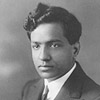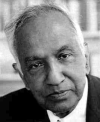Chandra: The Man Behind The Name
| NASA's premier X-ray observatory was named the Chandra X-ray Observatory in honor of the late Indian-American Nobel laureate, Subrahmanyan Chandrasekhar. Known to the world as Chandra (which means "moon" or "luminous" in Sanskrit), he was widely regarded as one of the foremost astrophysicists of the twentieth century. Chandra immigrated in 1937 from India to the United States, where he joined the faculty of the University of Chicago, a position he remained at until his death. He and his wife became American citizens in 1953. |  Chandra in his early years |
 Chandra in his middle years |
Trained as a physicist at Presidency College, in Madras, India and at the University of Cambridge, in England, he was one of the first scientists to combine the disciplines of physics and astronomy. Early in his career he demonstrated that there is an upper limit now called the Chandrasekhar limit to the mass of a white dwarf star. A white dwarf is the last stage in the evolution of a star such as the Sun. When the nuclear energy source in the center of a star such as the Sun is exhausted, it collapses to form a white dwarf. This discovery is basic to much of modern astrophysics, since it shows that stars much more massive than the sun must either explode or form black holes |
| Chandra was a popular teacher who guided over fifty students to their Ph.D.s. His research explored nearly all branches of theoretical astrophysics and he published ten books, each covering a different topic, including one on the relationship between art and science. For 19 years, he served as editor of the Astrophysical Journal and turned it into a world-class publication. In 1983, Chandra was awarded the Nobel prize for his theoretical studies of the physical processes important to the structure and evolution of stars. |  Chandra in his later years Chandra in his later years |
According to Nobel laureate Hans Bethe, "Chandra was a first-rate astrophysicist and a beautiful and warm human being. I am happy to have known him."
Visit our new web site at http://chandra.harvard.edu